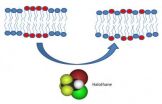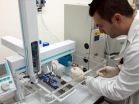(Press-News.org) Why does inhaling anesthetics cause unconsciousness? New insights into this century-and-a-half-old question may spring from research performed at the National Institute of Standards and Technology (NIST).* Scientists from NIST and the National Institutes of Health have found hints that anesthesia may affect the organization of fat molecules, or lipids, in a cell's outer membrane—potentially altering the ability to send signals along nerve cell membranes.
"A better fundamental understanding of inhaled anesthetics could allow us to design better ones with fewer side effects," says Hirsh Nanda, a scientist at the NIST Center for Neutron Research (NCNR). "How these chemicals work in the body is a scientific mystery that stretches back to the Civil War."
At the turn of the 20th century, doctors suspected inhaled anesthetics had some effect on cell membranes, an animal cell's outer boundary. Despite considerable investigation, however, no one was able to demonstrate that anesthetics produced changes in the physical properties of membranes large enough to cause anesthesia. But eventually, understanding of membrane function grew more refined as scientists learned more about ion channels.
Ion channels—large proteins embedded in the relatively small lipid molecules forming the membrane—are responsible for conducting electrical impulses along nerve cells in the brain and throughout our body. By a few decades ago, the prevailing theory held that inhaled anesthetics directly interacted with these protein channels, affecting their behavior in some fashion. But no one could find a single type of ion channel that reacted to anesthetics in a way pivotal enough to settle the matter, and the question remained open.
"That's where we picked up the thread," says Nanda. "We had been looking at how different types of lipid molecules affect ion channels."
While a cell membrane is a highly fluid film made of many different kinds of lipid molecules, the region immediately surrounding an ion channel often consists of a single type of lipids that form a sort of "raft" that is more ordered and less fluid then the rest of the membrane. When the team heard other researchers had found that disrupting these lipid rafts could affect a channel's function, they put to work their own previous experience working with the channels.
"We decided to test whether inhaled anesthetics could have an effect on rafts in model cell membranes," Nanda says. "No one had thought to ask the question before."
Using the NCNR's neutron and X-ray diffraction devices as their microscope, the team explored how a model cell membrane responded to two chemicals—inhaled anesthetic, and another that has many of the same chemical properties as anesthetic but does not cause unconsciousness. Their finding showed a distinct difference in the way the lipid rafts responded: Exposing the membranes to an anesthetic caused the rafts to grow disorderly, freely mixing its lipids with the surrounding membrane, but the second chemical had a dramatically smaller effect.
While Nanda says the discovery does not answer the question definitively, he and his co-authors are following up with other experiments that could clarify the issue. "We feel the discovery has opened up an entirely new line of inquiry into this very old puzzle," he says.
INFORMATION:
* M. Weinrich, H. Nanda, D.L. Worcester, C.F. Majkrzak, B.B. Maranville and S.M. Bezrukov. Halothane changes the domain structure of a binary lipid membrane. Langmuir, Feb. 21, 2012. DOI: dx.doi.org/10.1021/la204317k.
NIST findings awaken age-old anesthesia question
2012-03-22
ELSE PRESS RELEASES FROM THIS DATE:
How the alphabet of data processing is growing: Research team generates flying 'qubits'
2012-03-22
The alphabet of data processing could include more elements than the "0" and "1" in future. An international research team has achieved a new kind of bit with single electrons, called quantum bits, or qubits. With them, considerably more than two states can be defined. So far, quantum bits have only existed in relatively large vacuum chambers. The team has now generated them in semiconductors. They have put an effect in practice, which the RUB physicist Prof. Dr. Andreas Wieck had already theoretically predicted 22 years ago. This represents another step along the path ...
Berkeley Lab study shows far higher potential for wind energy in India than previously estimated
2012-03-22
A new assessment of wind energy in India by Lawrence Berkeley National Laboratory has found that the potential for on-shore wind energy deployment is far higher than the official estimates— about 20 times and up to 30 times greater than the current government estimate of 102 gigawatts. This landmark finding may have significant impact on India's renewable energy strategy as it attempts to cope with a massive and chronic shortage of electricity.
"The main importance of this study, why it's groundbreaking, is that wind is one of the most cost-effective and mature renewable ...
Scientists use rare mineral to correlate past climate events in Europe, Antarctica
2012-03-22
The first day of spring brought record high temperatures across the northern part of the United States, while much of the Southwest was digging out from a record-breaking spring snowstorm. The weather, it seems, has gone topsy-turvy. Are the phenomena related? Are climate changes in one part of the world felt half a world away?
To understand the present, scientists look for ways to unlock information about past climate hidden in the fossil record. A team of scientists led by Syracuse University geochemist Zunli Lu has found a new key in the form of ikaite, a rare mineral ...
Survey Reveals Private Investors Have More Confidence in the Stock Market
2012-03-22
A new survey commissioned by Lloyds TSB Private Banking has found the highest level of equity investment at any time in the past three and a half years.
- The Investor Outlook survey by Lloyds TSB reveals investors have more in equities than at any time in the last three and a half years
- Equities are good value after a period of price weakness
- After months of risk-aversion, investors have more faith in stock market
The Investor Outlook survey by Lloyds TSB Private Banking, a provider of international wealth management services, has revealed that private investors ...
Keeping track to selenium metabolism
2012-03-22
Spanish and Danish researchers have developed a method for the in vivo study of the unknown metabolism of selenium, an essential element for living beings. The technique can help clarify whether or not it possesses the anti-tumour properties that have been attributed to it and yet have not been verified through clinical trials.
"It is vox populi that doctors around the world recommend selenium supplements to complement traditional therapy against cancer and the AIDS virus but the truth is that the basics of these properties are not clear," explains to SINC Justo Giner, ...
Diet may be affecting rhino reproduction
2012-03-22
Southern white rhinoceros populations, once thriving in zoos, have been showing severely reduced reproductivity among the captive-born population. San Diego Zoo Global researchers have a possible lead into why the southern white rhinoceros population in managed-care facilities is declining: phytoestrogens in their diet might be contributing to reproductive failure in the females.
"Understanding why the captive white rhinoceros population has been dwindling for decades is an important part of protecting the future of this species," said Christopher Tubbs, researcher with ...
'Obscurins' in breast tissue may help physicians predict and detect breast cancer
2012-03-22
Bethesda, MD—A new discovery published online in The FASEB Journal (http://www.fasebj.org) may lead to a new tool to help physicians assess breast cancer risk as well as diagnose the disease. In the report, researchers from Johns Hopkins University and the University of Maryland, explain how proteins, called "obscurins," once believed to only be in muscle cells, act as "tumor suppressor genes" in the breast. When their expression is lost, or their genes mutated in epithelial cells of the breast, cancer develops. It promises to tell physicians how breast cancer develops ...
Study: Low bone density medications may have protective effect on endometrial cancer
2012-03-22
DETROIT: Low bone density medications, such as Fosamax, Boniva and Actonel, may have a protective effect for endometrial cancer, according to a study at Henry Ford Hospital.
Endometrial cancer affects more than 45,000 women a year in the U.S., usually in their 60s, although it can occur before 40. A type of uterine cancer, it's the most commonly diagnosed gynecologic cancer, and there is no known preventive medication for women at high risk of developing it.
"The results of the study suggest that use of low bone density medications may have a protective effect on ...
Fleet Enterprises, LLC Awards a New Multi-Unit Franchise Agreement Latest Franchise Growth Includes Metro Areas in Indiana and Ohio
2012-03-22
Fleet Enterprises, a fleet maintenance company that provides mobile repair and maintenance services to the transportation industry, has announced that it has awarded a six-territory franchise agreement to Jerry Duda, as it continues to expand its franchise network presence throughout the Midwest region of the United States.
With rights to open operations in Indiana and Ohio, the first of the new franchised operations opened in Indianapolis in early February of this year, with two more currently underway. By the end of the year, three additional franchise locations are ...
Computer model of spread of dementia can predict future disease patterns years before they occur
2012-03-22
NEW YORK (March 21, 2012) -- Researchers at Weill Cornell Medical College have developed a computer program that has tracked the manner in which different forms of dementia spread within a human brain. They say their mathematic model can be used to predict where and approximately when an individual patient's brain will suffer from the spread, neuron to neuron, of "prion-like" toxic proteins -- a process they say underlies all forms of dementia.
Their findings, published in the March 22 issue of Neuron, could help patients and their families confirm a diagnosis of dementia ...

